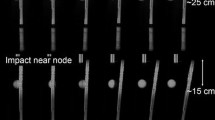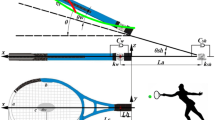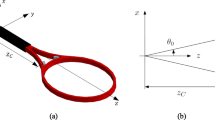Abstract
A forward dynamics computer simulation for replicating tennis racket/ball impacts is described consisting of two rigid segments coupled with two degrees of rotational freedom for the racket frame, nine equally spaced point masses connected by 24 visco-elastic springs for the string-bed and a point mass visco-elastic ball model. The first and second modal responses both in and perpendicular to the racket string-bed plane have been reproduced for two contrasting racket frames, each strung at a high and a low tension. Ball/string-bed normal impact simulations of real impacts at nine locations on each string-bed and six different initial ball velocities resulted in <3% RMS error in rebound velocity (over the 16–27 m/s range observed). The RMS difference between simulated and measured oblique impact rebound angles across nine impact locations was 1°. Thus, careful measurement of ball and racket characteristics to configure the model parameters enables researchers to accurately introduce ball impact at different locations and subsequent modal response of the tennis racket to rigid body simulations of tennis strokes without punitive computational cost.







Similar content being viewed by others
References
Brannigan M, Adali S (1981) Mathematical modeling and simulation of a tennis racket. Med Sci Sports Exerc 13:44–53
Brody H (1985) The moment of inertia of a tennis racket. Phys Teach 23:213–216
Brody H (1997) The physics of tennis III: the ball–racket interaction. Am J Phys 65:981–987
Corana A, Marchesi M, Martini C, Ridella S (1987) Minimizing multimodal functions of continuous variables with the “Simulated Annealing” algorithm. ACM Trans Math Softw 13:262–280
Cottey R, Kotze J, Lammer H, Zirngibl W (2006) An extended study investigating the effects of tennis rackets with active damping technology on the symptoms of tennis elbow. Eng Sport 6(9):391–396
Davies G (2005) Feel and tennis ball impacts. PhD thesis, Loughborough University
De Smedt T, de Jong A, Van Leemput W, Lieven D, Van Glabbeekk F (2007) Lateral epicondylitis in tennis: update on aetiology, biomechanics and treatment. Br J Sports Med 41:816–819
Dignall RJ, Haake SJ, Chadwick SG (2000) Modelling of an oblique tennis ball impact on a court surface. In: Subic AJ, Haake SJ (eds) The Engineering of Sport. Blackwell Sciences, Oxford, pp 185–192
Glynn JA, Kentel BB, King MA, Mitchell SR (2007) A comparison of wrist angular kinematics and forearm EMG data for an elite, intermediate and novice standard tennis player performing a one-handed backhand groundstroke. Int J Sports Sci Eng 01:157–164
Goodwill SR Haake SJ (2003) Modelling of an impact between a tennis ball and racket. In: Miller S (ed) 2nd international tennis, science and technology, Blackwell, Oxford
Hatch GF, Pink MM, Mohr KJ, Sethi PM, Jobe FW (2006) The effect of tennis racket grip size on forearm muscle firing patterns. Am J Sports Med 34:1977–1983
Hennig EM, Rosenbaum D, Milani TL (1992) Transfer of tennis racket vibrations onto the human forearm. Med Sci Sports Exerc 24:1134–1140
Hocknell A, Mitchell SR, Jones R, Rothberg SJ (1998) Hollow golf club head modal characteristics: determination and impact applications. Exp mech 38:140–146
International Tennis Federation (2004). ITF approved tennis balls & classified court surfaces—a guide to products and test methods. ITF Licensing (UK) Ltd, London, pp 4–20
Li FX, Fewtrell D, Jenkins M (2004) String vibration dampers do not reduce racket frame vibration transfer to the forearm. J Sports Sci 22:1041–1052
Mitchell SR, Jones R, King M (2000) Head speed vs. racket inertia in the tennis serve. Sports Eng 3:99–110
Nesbit SN, Elzinga M, Herchenroder C, Serrano M (2006) The effects of racket inertia tensor on elbow loadings and racket behaviour for central and eccentric impacts. J Sports Sci Med 5:304–317
Riek S, Chapman AE, Milner T (1999) A simulation of muscle force and internal kinematics of extensor carpi radialis brevis during backhand tennis stroke: implications for injury. Clin Biomech 14:477–483
Schlarb H, Kneib B, Glitsch U (1998) Modelling of the elastic racket properties in the dynamic computer simulation of tennis. In: Riehle H, Vieten M (eds) Proceedings of the XVI international symposium on biomechanics in sports, Konstanz, Germany pp 379–382
Stroede CL, Nobel L, Walker HS (1999) The effect of tennis racket string vibration dampers on racket handle vibration and discomfort following impacts. J Sports Sci 17:379–385
Yeadon MR, Challis JH (1994) The future of performance-related sports biomechanics research. J Sports Sci 12:3–32
Acknowledgments
The authors would like to acknowledge Head AG and the UK EPSRC for supporting this research.
Author information
Authors and Affiliations
Corresponding author
Rights and permissions
About this article
Cite this article
Glynn, J.A., King, M.A. & Mitchell, S.R. A computer simulation model of tennis racket/ball impacts. Sports Eng 13, 65–72 (2011). https://doi.org/10.1007/s12283-010-0056-x
Published:
Issue Date:
DOI: https://doi.org/10.1007/s12283-010-0056-x




